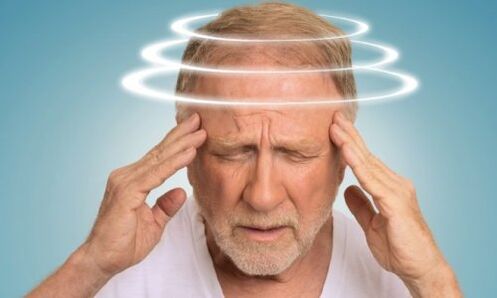Experts call the prostate gland the most vulnerable organ in men. It is the most common inflammation of the prostate that causes a lot of discomfort to the patient. If the inflammatory process lasts for more than 3 months, we can talk about a chronic form of the disease. Not all thirds of the stronger face the problem of treating chronic prostatitis. It is possible to cure the disease, but this requires professional medical help. It should not delay the complex treatment of a chronic disease because it triggers the onset of adenoma and prostatic hyperplasia as well as a decrease in erectile function.

What does the diagnosis mean?
In general, men are reluctant to listen for their own well-being, so the inflammatory process in the prostate takes a protracted form. The danger of the disease is that it can be completely asymptomatic. First, urethritis develops, and if you do not seek medical attention, complications cannot be avoided. Over time, men develop chronic prostatitis, the symptoms and treatment of which are individual. Forms of chronic prostatitis:
| Name | Diagnostics |
|---|---|
| infectious | Occurs due to damage to the prostate caused by viruses, fungi, or bacteria. It is detected by laboratory analysis of blood and urine. |
| stagnation | It is associated with pain in the pelvic area, most often chronic. The symptoms of a stagnant form are sometimes similar to the signs of an inflammatory process. |
| Asymptomatic | The inflammation has no clinical manifestations, so a man may not see a doctor for a long time. The disease can only be identified by examining the prostate gland. |
Many men are diagnosed with congestive chronic prostatitis (a non-infectious etiology). Inflammation in this case affects the secretion of the prostate and veins.
Reasons for appearance
The causes of chronic prostatitis are varied:
- Prolonged abstinence from intimacy or overactive sex life;
- Presence of multiple perineal injuries (while riding or cycling);
- Irrational menu (lack of nutrients and excess of fried, fatty and smoked foods);
- Repeated genital infection;
- Decreased immunity;
- Diseases of the urogenital organs;
- Inactive and sedentary lifestyle;
- Too tight and tight underwear;
- Coitus interruptus;
- Phimosis in history;
- Anal sex without additional protection (condoms).
The disease affects both the elderly and middle-aged and even young men:
- In an inactive sex life, prostatitis occurs due to stagnation of prostate secretion.
- Athletes are at risk because they lift weights and are prone to microtrauma to prostate tissue.
- Drivers of long-haul flights suffer from stagnation of blood in the pelvic organs.
- Fans of winter fishing are at risk due to the body’s constant hypothermia.
Chronic prostatitis is about 20% of common male diseases. One in five patients see a doctor suffers from a chronic form of the disease. The disease is "rejuvenating" because modern guys are gentle, not thinking about their own safety. In order not to care about how to get rid of chronic prostatitis, it is enough to provide basic protection against sexually transmitted diseases.

It is worth considering that the chronic form of the disease leads to a violation of the erection of the penis and a decrease in sexual satisfaction during ejaculation. It is on this basis that the fear of intimacy, irritability, and lack of self-confidence begin. All this leads to neuroses of sexual origin.
Ways of infection
Doctors observe two types of infection with an infectious form of prostatitis:
- Urinogen (ascending). Specific microorganisms enter the prostate through the urethra. The secret of the prostate is normally sterile, no bacteria are detected during the test. There are cases where microorganisms live in the human body but their concentration is not sufficient to cause the disease. If the microflora is disrupted, infection of the organ begins, leading to inflammation. Do not rule out the risk of infection and damage to adjacent organs if a man suffers from hemorrhoids or cystitis. In this case, dangerous microorganisms enter the prostate via the lymphogen pathway.
- Hematogenous. The pathogen of the infection enters the prostate through the bloodstream. The diseases that cause these types of infections are varied: acute flu, caries, and so on. If you have concomitant venous congestion of the prostate gland, there is a high risk of chronic prostatitis, which takes a long time to treat.
Urologists identify two predisposing factors that lead to hematogenous infection:
- He was born. Anatomical features of the prostate, including changes in muscle tissue structure or circulatory disorders.
- He got it. Causes of chronic prostatitis include genital trauma, craving for alcohol, prolonged smoking, a history of infectious diseases, and frequent hypothermia.
The danger of ignoring the disease lies in the fact that at this stage, the symptoms of chronic prostatitis in men are most often absent or insignificant. The patient believes that the disease can be cured with folk remedies, but these methods are ineffective. The treatment regimen should only be prepared by a specialist after a thorough examination and collection of the necessary information.
Warning signs
Symptoms of chronic prostatitis vary depending on the stage and form of the disease:
| The form | signs |
|---|---|
| Bacterial | Feeling weak, chills, fever, muscle aches in the lower abdomen (may be aggravated by intercourse and prolonged abstinence), pain when urinating, weak urine pressure, frequent urination at night. Pain is observed in the thighs, perineum, and rectum, so signs of chronic prostatitis are confused with hemorrhoids. |
| Bacterial specific | All of the above signs can be observed, to which mucosal secretions from the urethra can be added. |
| abacterial | The symptoms of congestive prostatitis are difficult to ignore due to the severe pain. It is localized in the perineum and thighs. There is an uncomfortable feeling in the head of the penis. The pain is exacerbated by interruption of sexual intercourse as well as prolonged abstinence from intimacy. |
The consequences of chronic prostatitis depend on the duration of the disease:
- adenoma;
- Oncology;
- Sclerosis of the prostate and bladder neck;
- Erectile dysfunction;
- Infertility;
- Decreased testosterone levels.
The danger of the disease lies not only in the fact that inflammation of the prostate can be confused with another disease. If the acute phase passes, the symptoms of chronic prostatitis disappear and no treatment is given. The man is no longer worried about his health and is not going to see a doctor. However, the time will come when the signs will start to get seriously annoying and disrupt normal life, but the disease has already entered a protracted phase. Treatment for congestive prostatitis takes much longer if the diagnosis of the disease was not in the first stage.

Diagnosis
The symptoms of other diseases are very similar to those of chronic prostatitis. Is it possible to cure the disease without tests? It is unlikely because only an accurate diagnosis determines the form and stage of development of prostatitis. The discomfort can be caused by:
- tuberculosis;
- adenoma;
- Tumor.
Only a complete examination can confirm or rule out a diagnosis. There are two types of research:
- Instrumental;
- Laboratory.
After talking to the patient and taking a medical history, the urologist or andrologist will ask you to have a series of tests:
- general urine analysis;
- general blood test;
- Analysis of prostate secretion;
- Blood test for PSA.
We take urine samples three times to get more accurate information about the change in composition:
- epithelial cells;
- Leukocytes;
- Pathogenic pathogens of infections;
- Non-specific bacteria.
Doctors know what chronic prostatitis is and how difficult it is to diagnose. The modern method of transrectal ultrasound (TRUS) allows this to be done accurately:
- A device with an ultrasound probe is carefully inserted into the patient's anus.
- Because the prostate is tightly connected to the rectal wall, one skilled in the art will have a good opportunity to study the prostate gland in detail and make an accurate diagnosis.
Conventional ultrasound allows the determination of prostate density, size, and the presence of fibrous foci, abscesses, and tartar.
Before treating chronic inflammation of the prostate, the doctor should double-check the diagnosis. In the slightest doubt, the patient may be referred for an MRI or CT scan to rule out the presence of cancerous focus. If a man has infrared obstruction, an x-ray will be needed to determine the cause of the disease.
Conservative treatments

The treatment regimen for chronic prostatitis is prescribed by a professional urologist and is selected individually. The doctor will consider the cause of the disease, the duration of the disease, and a factor such as an aggravating pathology. If congestive or infectious prostatitis is in the early stages, treatment may be medication:
- Antibiotic therapy. Prostatitis can be treated with antibacterial drugs if the bacterial agent is detected in the prostate secretions or urine. The inflammation must be pronounced. The course lasts up to 2 months and the cost of treating chronic prostatitis depends on the medications prescribed. The dosage of each drug is prescribed individually and self-medication is complicated. Opinions following treatment of prostatitis with antibiotics are not always positive, but there are reasons for this. Sometimes the symptoms persist at the end of the course, even though the infection has been defeated.
- Elimination of symptoms. Drugs that relieve pain are often used to treat chronic inflammation of the prostate in men. Antidepressants can also be used during therapy to reduce anxiety.
- Alpha blockers. A course of these medications is prescribed if your doctor has diagnosed hypertension in your bladder muscles or increased intraurethral pressure. However, the drugs are ineffective if the patient has pelvic floor myodystrophy or impaired muscle innervation.
- hormone therapy. It is based on the results of a hormonal test. Androgens and antiandrogens are used.
- Vitamin therapy. Irrational nutrition makes up for the lack of nutrients due to the vitamin-mineral complex. Experts do not recommend replacing it with popular dietary supplements, as the "puppet" does not help in any way.
- Normalization of uric acid levels. Methods of treating chronic prostatitis with regulators are effective only in the presence of prostate stones.
- Immunostimulants. Prostatitis is treated in this way only in the case of laboratory-confirmed immunodeficiency.
In answer to the question of whether chronic prostatitis is curable, we can safely say that healing occurs quickly with a properly prescribed complex.
Operational management method
Generally, the disease does not require surgery unless the complication poses a threat to the patient’s health or even life. Modern surgery performs endoscopic surgery to reduce risks and damage to health. Surgery is essential:
- adenoma;
- Nuclear tuberculosis sclerosis;
- Stones in the prostate;
- Prostate sclerosis.
Effective treatment of chronic prostatitis allows a man to see a doctor in time without surgery. Keep in mind that surgery cannot be performed during the disease exacerbation phase. The need for such a cardinal treatment method will only be determined by the surgeon after studying the general clinical picture.
Other treatments
Men are often worried about whether chronic prostatitis can be cured non-medically. Your doctor may prescribe other methods:
- Massage. Do not forget about the contraindications and the fact that only a small area of the prostate is available for massage. If there are hyperplastic lesions in the prostate gland, a massage regimen can lead to acute urinary retention. This in turn provokes further spread of inflammation and the development of sepsis. Massage in the presence of venous congestion, prostate cysts and stones in the prostate gland is also prohibited. If you need to get rid of a stagnant secret, it is better to free your prostate by ejaculation.
- Special gymnastics. It is used to strengthen the bladder and prolong the urination intervals. Improving the tone of the sphincter and bladder allows you to set a break of up to 5 hours between stimuli with the toilet. Gymnastics is ineffective for neurodystrophic lesions and myofascial syndrome.
- Muscle stimulation. Magnetic therapy, phonophoresis, transrectal ultrasound, or electrical stimulation are used to reduce the tone of the pelvic floor muscles.
- Instillation. It is practically not used in modern medicine because injecting drugs into the urethra is painful and does not cure prostatitis. The consequences of such treatment can be catastrophic.
It is advisable to consult an andrologist or urologist for the treatment of congestive prostatitis with folk remedies. Popular videos on the Internet are full of videos on the quality use of alcoholic tinctures and pumpkin seeds, but there is no substitute for drug therapy. Also, it is only the doctor who determines how well they treat the disease, not the heroes of YouTube.
Useful exercises
A simple set of exercises improves blood microcirculation in the pool area. Instead of the usual exercises, you can do it in the morning:
- Secure your legs shoulder-width apart, raise your arms, and attach them to the back of your head. Inhale - sit down slowly and spread your knees to the side, breathe out - return to starting position.
- Tie your legs together, let your hands release your body. Bend your left leg to your knees, lift it as high as possible. Repeat with the right foot. Run 10 approaches.
- Squatting down, palms down. Inhale - rise slowly, spread your arms to the side. Exhalation - return to starting position.
- Lie on your stomach after you put a small ball under it (no bigger than a tennis ball). Concentrate on the floor and roll the ball to the ground with your belly. Run 7 approaches.
- Lie on your back, bend your knees. Squeeze the ball between them. Inhale, squeeze your knees, exhale - relax. Perform 3 sequences, eventually increasing the number of repetitions up to 9 times.
- Sit down on the floor, focusing on your hands. Place a ball under your bottom. Try to roll on the floor using your buttocks and genitals.
Help in the fight against the disease and Kegel exercises that benefit not only women but also men.
Probable forecasts
Instead of looking for information on how to treat chronic prostatitis, it is more helpful to make an appointment with a professional. You can improve your health by consulting a doctor in time and with a reasonably chosen therapeutic course. The question of whether chronic prostatitis is completely curable cannot be answered unequivocally. It all depends on what methods your doctor has prescribed and how closely you follow the patient’s recommendations.
Experts are very careful about the further course of the disease. Is chronic prostatitis guaranteed? Complete recovery has only been observed in rare cases, as the disease most often occurs in the form of prolonged remission. Normalization of urine and blood parameters can be observed, the symptoms disappear completely. However, without following your doctor's advice, the disease can again cause discomfort and complications.



























